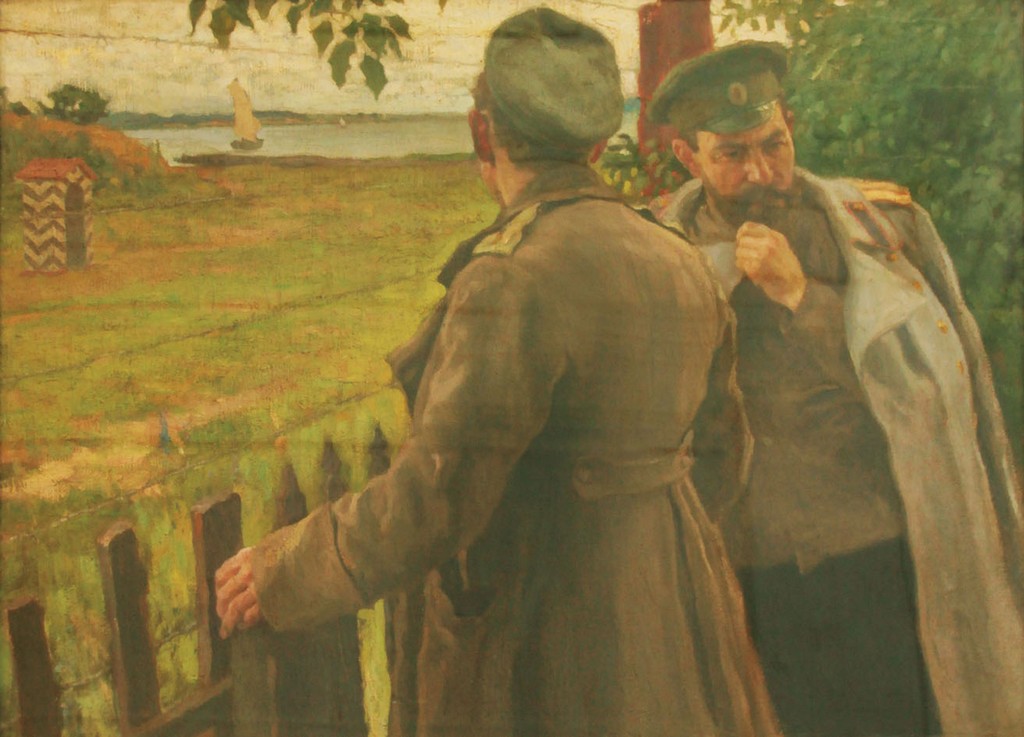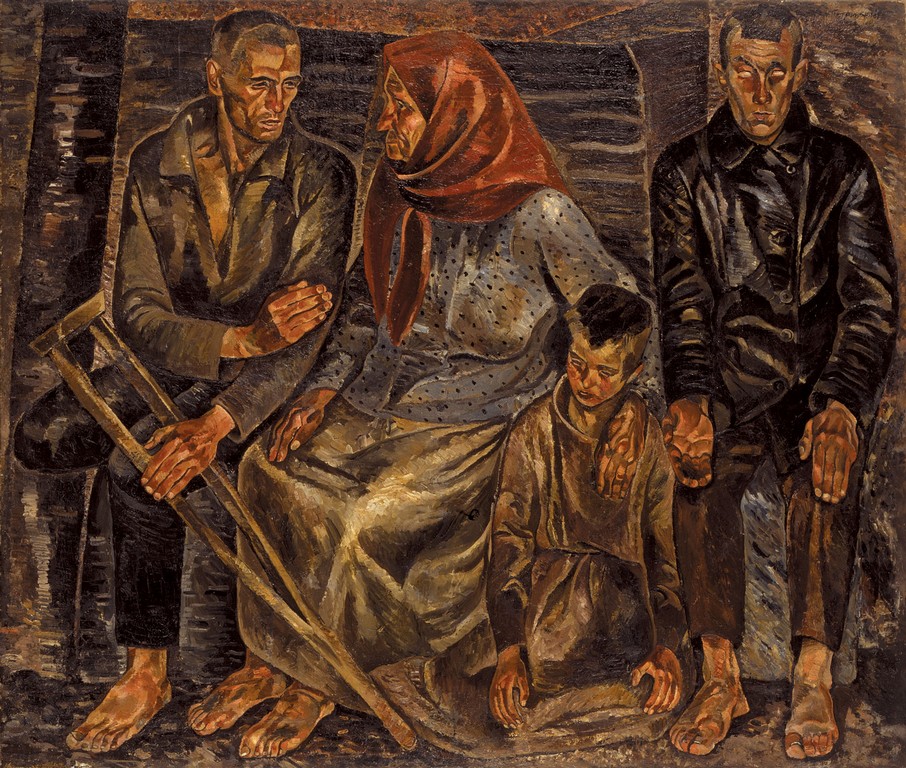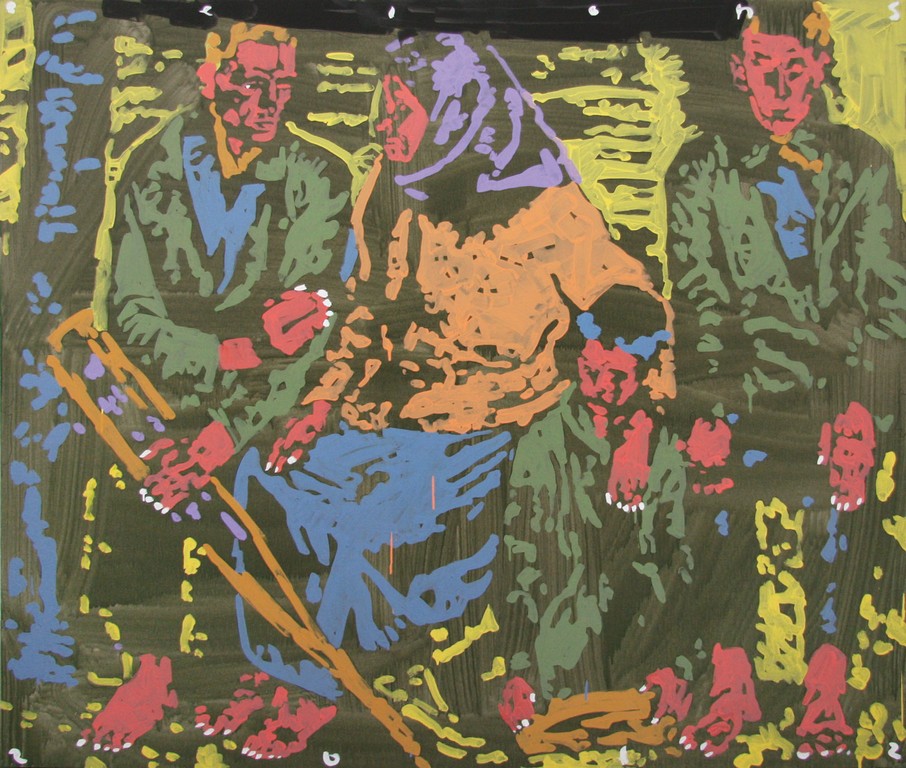 Halyna Boroday, In memory of Oleksiy Venetsyanov, 1979-1980, сanvas, oils. 175x155
Halyna Boroday, In memory of Oleksiy Venetsyanov, 1979-1980, сanvas, oils. 175x155 Mykola Bilous, Summer, 2012, acrilyc on canvas, 150х150 cm
Mykola Bilous, Summer, 2012, acrilyc on canvas, 150х150 cm Petro Rybka, Cossack Mamai,1855, canvas, oils. 70x83 cm
Petro Rybka, Cossack Mamai,1855, canvas, oils. 70x83 cm Mykola Bilous, Mamai, 2012, acrilyc on canvas, 110х150 cm
Mykola Bilous, Mamai, 2012, acrilyc on canvas, 110х150 cm Serhiy Svitoslavsky, Bullocks on tillage, 1891, оil on canvas, 80х126 cm
Serhiy Svitoslavsky, Bullocks on tillage, 1891, оil on canvas, 80х126 cm Mykola Bilous, Oxen, 2012, acrilyc on canvas, 80х150сm
Mykola Bilous, Oxen, 2012, acrilyc on canvas, 80х150сm Mykola Pimonenko, Near the well. Rivals, оil on canvas, 148х194 cm
Mykola Pimonenko, Near the well. Rivals, оil on canvas, 148х194 cm Mykola Bilous, The Calf, 2012, acrilyc on canvas, 130х150 cm
Mykola Bilous, The Calf, 2012, acrilyc on canvas, 130х150 cm Volodymyr Kostetskyi, Return, 1947, оil on canvas, 196х150
Volodymyr Kostetskyi, Return, 1947, оil on canvas, 196х150 Mykola Bilous, Father, 2012, acrilyc on canvas, 150х100
Mykola Bilous, Father, 2012, acrilyc on canvas, 150х100  Kapition Pavlov, Artist’s Children, 1837, оil on canvas. 66х89
Kapition Pavlov, Artist’s Children, 1837, оil on canvas. 66х89 Mykola Bilous, Children with grapes, 2012, acrilyc on canvas, 110х150
Mykola Bilous, Children with grapes, 2012, acrilyc on canvas, 110х150  Anonymous master, Samson. Late 18th c., wood, polychromy. 159х60х94
Anonymous master, Samson. Late 18th c., wood, polychromy. 159х60х94 Mykola Bilous, Samson, 2012, acrilyc on canvas, 150х100
Mykola Bilous, Samson, 2012, acrilyc on canvas, 150х100  Oleksandr Murashko, Winter, 1905 – 1906, оil on canvas, 89х140
Oleksandr Murashko, Winter, 1905 – 1906, оil on canvas, 89х140 Mykola Bilous, Coldly, 2012 , acrilyc on canvas, 150х110
Mykola Bilous, Coldly, 2012 , acrilyc on canvas, 150х110  Semen Prokhorov, Two Prisoners of War, оil on canvas, 74х88,5
Semen Prokhorov, Two Prisoners of War, оil on canvas, 74х88,5  Mykola Bilous, Whiteguards, 2012, acrilyc on canvas, 150х150 cm
Mykola Bilous, Whiteguards, 2012, acrilyc on canvas, 150х150 cm Volodymyr Orlovsky, In Beech Forest, 1881, оil on canvas, 173х139,5 cm
Volodymyr Orlovsky, In Beech Forest, 1881, оil on canvas, 173х139,5 cm Mykola Bilous, The Forest, 2012, acrilyc on canvas, 150х120 cm
Mykola Bilous, The Forest, 2012, acrilyc on canvas, 150х120 cm Anatoly Petrytskyi, Invalids, 1924, оil on canvas, 167х194 cm
Anatoly Petrytskyi, Invalids, 1924, оil on canvas, 167х194 cm Mykola Bilous, The Poverty, 2012, acrilyc on canvas, 150х170 cm
Mykola Bilous, The Poverty, 2012, acrilyc on canvas, 150х170 cm Fedir Krychevsky, triptych "Life", 1925 – 1927, the left part "Love", tempera on canvas, 177х85
Fedir Krychevsky, triptych "Life", 1925 – 1927, the left part "Love", tempera on canvas, 177х85 Mykola Bilous, Kiss, 2012, acrilyc on canvas, 150х100 cm
Mykola Bilous, Kiss, 2012, acrilyc on canvas, 150х100 cm Fedir Krychevsky, Bride,1910, оil on canvas. 210х292 cm
Fedir Krychevsky, Bride,1910, оil on canvas. 210х292 cm Mykola Bilous, Witch, 2012, acrilyc on canvas, 150х200 cm
Mykola Bilous, Witch, 2012, acrilyc on canvas, 150х200 cm Ivan-Valentyn Zadorozhnyi, Bread of life, 1984 – 1985, tempera on canvas. 182х175 cm
Ivan-Valentyn Zadorozhnyi, Bread of life, 1984 – 1985, tempera on canvas. 182х175 cm Mykola Bilous, Bread, 2012, acrilyc on canvas, 120х150 cm
Mykola Bilous, Bread, 2012, acrilyc on canvas, 120х150 cm Oksana Pavlenko, Long live the eight of March!, 1930-1931, tempera on canvas. 150х115 cm
Oksana Pavlenko, Long live the eight of March!, 1930-1931, tempera on canvas. 150х115 cm Mykola Bilous, Celebration of women, 2012, acrilyc on canvas, 110х150 cm
Mykola Bilous, Celebration of women, 2012, acrilyc on canvas, 110х150 cmMykola Bilous
CITATIONS
18.02 - 18.03.2012
Curator: Oksana Barshynova
NATIONAL ART MUSEUM OF UKRAINE
6 Grushevs’kogo Str., Kyiv.
www.namu.kiev.ua
Modern “Citations” on Ukrainian classics
On February 18, 2012 National art museum of Ukraine presents contemporary art exhibition “Citations” of the artist Mykola Bilous.
“Citations” are the master’s replicas of the famous Ukrainian classics available in permanent exhibitions of the museum. Images borrowed by Bilous become actualized and lose their “old-fashioned eternity bearer” aura. Among those chosen by the artist are Fedir Krychevs’kyi, Anatol’ Petryts’kyi, Ivan-Valentyn Zadorozhnyi, Serhiy Svitoslavs’kyi, folk painting “Kozak Mamay”, “Samson” sculpture, Mykola Pymonenko, Oleksandr Murashko and other classics. After viewing of Mykola Bilous’s paintings visitors can see the museum exposition and find these classical works there.
Mykola Bilous thinks that quotations will help to re-read national arts heritage and unite tradition and modern times.
“Citations” exhibition will be held as a part of initiated in 2009 by the National art museum cooperation with the modern artists and promotion of the actual Ukrainian art in the traditional museum.
The project’s supervisor – Chief of the Art of the 20th – early 21stcc. section of National art museum of Ukraine Oksana Barshynova notes that common thinking existsregarding modern art separation and existence by its own. “But I think that it’s not true. Actual art is significantly interconnected with the past and is an organic part of the overall Ukrainian art tradition development’, - stresses Mrs. Barshynova.
The exhibition will take place with the help of the project’s patron OTP Bank. One of the “Citations” of Mykola Bilous the bank will present to National art museum of Ukraine.
__________________________________________________________________________________________________
The exhibition by Mykola Bilous «Citations» is organized in the framework of cooperation initiated by the National Arts Museum of Ukraine with contemporary artists, as well as promotion of the Ukrainian contemporary art at a traditional museum. The focus of our attention is an encounter of the established tradition and the creative vision of today, which creates lines of tension between the different periods of the national arts.
The idea of Mykola Bilous' project «Citations» appeared due to specific interest of the artist to the infinite circulation of images in the field of culture. In this regard, particularly fertile soil is represented by the collection of the National Arts Museum of Ukraine, where works by Ukrainian artists of the 18th-20th centuries make it possible to reveal the fundamental principle of culture – heredity and continuity of the tradition due to interpretation of predecessors' heritage.
Mykola Bilous discovered a specific artistic language, which is the result of his reflections on possible prospects of the contemporary art. His previous projects were associated with the high classics of cinematography – both feature and documentary one («The Man with the Movie Camera» (2008), «How the City Began» (2009), «The Unbearable Lightness of Being» (2010), etc., all of them – in the TSEKH gallery). The appeal to cinematography, caused by the desire to lean on a certain prototype, naturally led him to serial presentations, «storyboard» painting, through deprived of any narrative. The starting point of Mykola Bilous' painting was the analytical desire to use and reinterpret the composition and the specific light already discovered in the film frame, revealing the most generalized forms with the option of their subsequent abstraction. Thus, he saw it as his task to achieve a bright image laconic in the poster way, which does not simplify but activates the prototype.
Working on the project «Citations», Bilous applied the manner discovered by him to remove identity of individual artists and attribute the range of pieces developed by them with features of a homogeneous «movie». Relevant painting appears as translation of ideas using painting techniques, a technical tool like a camera or a video recorder, which set its own rules and technical parameters. Bilous has mastered the versatile technique, which is a means of filtering the powerful flow of images – in this case being masterpieces of the museum collection – he releases the image of information «noises», emphasizes the main thing targeted for immediate perception. This is the path that Bilous' favorite artist Roy Lichtenstein followed in his time – a star of pop art who in his mature years switched to development in his «comic strips» style of the classic history of the world arts. Lichtenstein claimed that by copying canvas of masters of modernism, he destroyed them, thus «releasing his art». The images that Bilous borrows from the exhibition of the National Arts Museum lose their aura of eternity media standing aloof from modernity. Among those he selected – Fedir Krychevsky, Anatoly Petrytskyi, Ivan-Valentyn Zadorozhnyi, Serhiy Svitoslavsky, the folk painting «Cossack Mamai», the sculpture «Samson», Mykola Pymonenko, Olexander Murashko, and other classicists. The key to understanding the project is the work by Galyna Boroday «In memory of Oleksiy Venetsyanov», in which the direct quote from the work of the Russian artist of the first half of the nineteenth century is dissolved in the meditative silence of Sedniv landscape, where a self-portrait is included into the picture, where there is no clear distinction between the modern and the long passed.
Mykola Bilous obtained fundamental academic education, had training in Europe, taught professional art disciplines at the key specialized university, and development of his own artistic idiom is the result of his reflections on the fate of arts in the twentieth century. Therefore, the project involves young art historians and students of 5th year of studies at the National Academy of Arts and Architecture, whose expression created the «parallel line» of the project – textual reflections on visual quotations by Bilous.
The exhibition by Mykola Bilous «Citations» touches upon the issues of new reading of the national artistic heritage, developing links between the tradition and modernity extremely relevant for today's Ukrainian culture. Actual painting, despite simplification, reliance on integral instant perception, vivid colors, refers to the most significant, primary function of arts important at all times of its development – to make one scrutinize, concentrate, and thus be in the field of action of a true artistic experience.
Oksana Barshynova,
the project's curator
__________________________________________________________________________________________________
In preparation of the «Citations» for students of 5th year of studies Faculty of Art Theory and History of the National Academy of Arts and Architecture was organized a meeting with Mykola Bilous. The results of conversations with the artist are small texts, which reflected the vision of young professionals of Bilous' works and its place in the Ukrainian modern art. Excerpts of them we've below present.
Works by Mykola Bilous are ascetic, they breathe with alienation. The canvas do not appeal to the audience's feelings, nor do they require its emotional response, they live as colorful volumetric forms in their planes not seeking for a way out of them, completely filling them. Asceticism can also be traced in the author's choice of the color palette. Bilous uses basic, foundational colors, which definitely fulfill their function: they convey live, vibrating suffering, passion, despair, exhalation, impulse, but in a concise presentation form.
Mykola Bilous is a hermit, a modern Gauguin who one day decided to risk everything daring uncertainty, choosing a new path. He is uncertain, he doubts, but he follows his own way. And outcomes soon become evident: art by Bilous stands aside, it is not contrasted or compared with works by any of modern Ukrainian artists, it does not fit into curators' highbrow and nonsensical projects.
Krystyna Zamostyanova
Scrutinizing works by Mykola Bilous, we seem to have in front of us still shots from movies. He applies fragmented composition offering the viewer a moment torn out of life. In the process of contemplating the works in this or that sequence, our imagination constellates a complete picture, a sort of a mini-movie (or – comic strips) created by the artist's imagination and observations and interpreted differently by everyone, in line with his / her own experience.
Yulia Pylypchuk
Mykola Bilous's love of cinematography is implied in the soul of his paintings. If one arranges the works as one line, one will see a certain painted "movie" having its beginning, development, and logical conclusion.
The artist is the producer and the cameraman. Decorations for his new type of cinema are the bright color, occasionally expressive presentation, and impulses of local spots, which also convey a mood – as it is conveyed by rain or sun. In today's world of virtual technologies, the author gives us a chance to see ourselves from aside, how we pseudo-perceive each other, but it happens not in real-time, tete-a-tete, but via the screen – or canvas, as in this case.
Alina Voronko
Pictures by M.Bilous are reflections on pop art, reconsideration of these methods in connection with his their own creative quest.
The works contain an element of abstraction: emphasis on the most important items, images, objects, their generalization – without time or specific space. The neutral black background intensifies this effect.
One can note that Mykola Bilous has discovered his own reality, authentic and settled, even though the way of self-expression and the technical method of all the series of paintings remain unchanged and the same, without diversity.
Zapleshna Yulia
Mykola Bilous is an artist with a difficult fate and a hard way toward self-discovery. He did not discover his artistic language – he reached it. Key aspects for him are not expressive tools or representation approaches, but experiencing each painting not marked by individual associations or emphasis on the plot.
He builds the form with basic and a few additional spectral colors against the black background. Thus, the image is perceived as simultaneously flat (due to the pure color) and volumetric (the black makes the rest of the colors stand out).
In Bilous' images – there are postmodernist quotations of the classics. The next step is quoting of quotations.
Maria Kabak
The poster style of the artist's works raises his images to the level of significance, and the signs dissolve in the ephemeral of the cinematographic life. Everything happens inside the painting, there is no dialogue with the audience, color virtually disappears, and its phantom stays behind as a memory of being. Black – the air, and the void simultaneously... or, maybe, not void but space, in which there is everything, all colors of the palette? However, it is not from black but from rough greenish that forms emerge, created with the limited palette of colors selected by the artist. Brush strokes are broad, bold and, at the same time, they melt away disappearing in each other, not mixing colors on the canvas. Shadows are absent, no semi-tones, the painting is executed locally, even a bit roughly, emphasizing flatness of the image.
Svitlana Yatsenko
Mykola Bilous fills his works with substance due to the color and form, not narration or the plot.
His creative method contributed into identification of an individual scale, unique as fingerprints, as features of each individual. It plays the primary role in his self-consciousness not only as an artist, but also as a personality as a whole.
The key colorist method of the artist is color inversion. He uses the contrast of color combinations, which is clearly expressed in interaction of the extreme saturation of local colors. This technique allows separating the foreground of the picture from the background, it makes one scrutinize the picture in a sequence set by the artist.
Olga Pisha
Mykola Bilous sees the role of an artist as that of a kind of a mediator whose task is receiving and transmitting information.
It should be noted that the original and easily recognizable style of the artist is based on combination of the relief and the flat. In his works, Mykola Bilous actively works with local colors, he uses the black, which "pushes" other colors towards the surface, which enriches the works with internal motion, vitality.
The key idea of works by Bilous is to show and to combine volume and color. When using such formal solution, the painting's plot loses its paramount importance offering the audience the chance of direct perception of the work.
PHOTOREPORT

